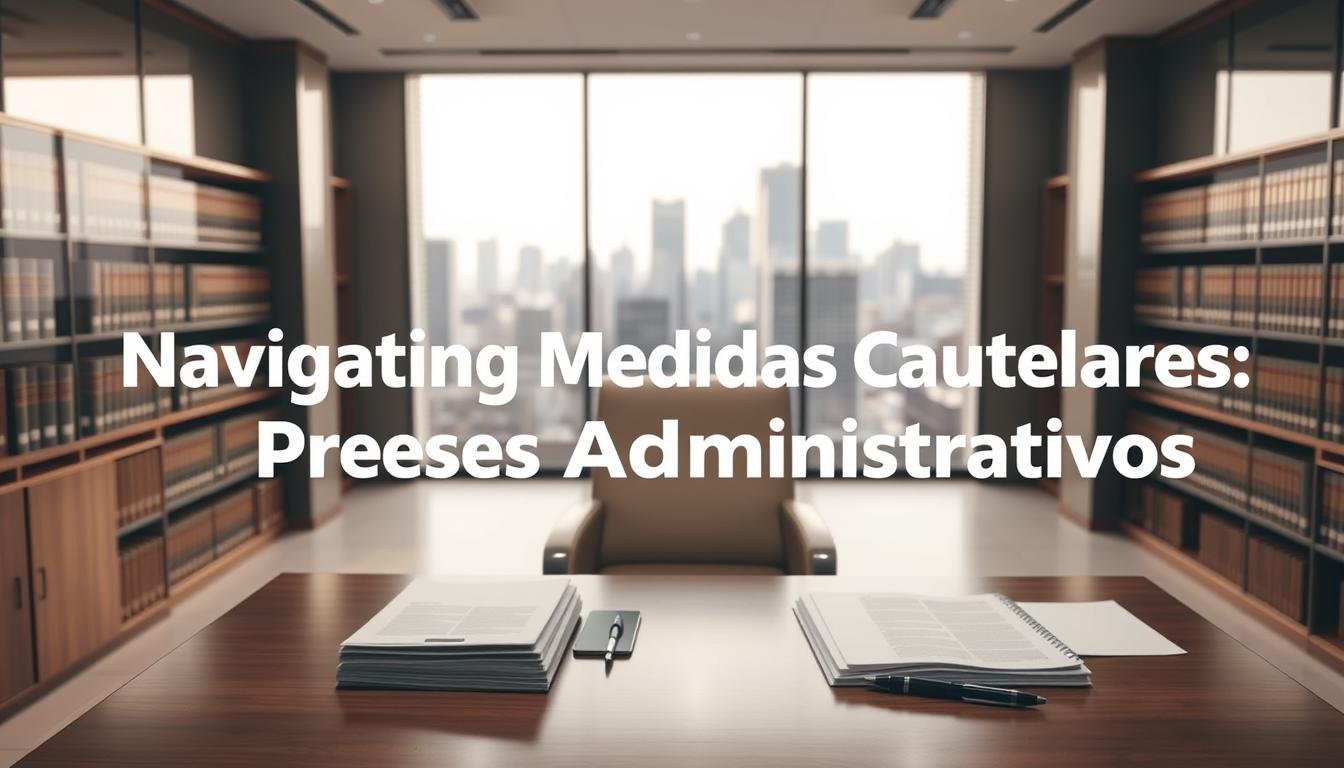Did you know that quick interim relief can decide whether a public contract survives or collapses within days?
I advise public entities and private contractors in Colombia on state contracting and sanctioning matters. I focus on using medidas cautiously to secure timely protección of derechos and business continuity.
My approach translates complex ley and jurisprudencia—especially CPACA Chapter XI and Sentencia C-284/14—into clear steps to request the right medida at the right time. I assess actos, map riesgo, and prepare persuasive evidence so a juez grants a decisión swiftly.
I handle the full procedimiento from risk triage to defensa and recursos, aligning strategies with appeal rules and the absence of bond in collective actions. For guided assistance, see my work with administrative law clients at administrative law specialists.
Key Takeaways
- I secure urgent protection to preserve contracts and rights in Colombia.
- My tactics follow CPACA arts. 229–241 and Sentencia C-284/14.
- I design medida requests based on riesgo of irreparable harm.
- No bond is required for collective rights actions under current jurisprudence.
- I coordinate defensa, recursos, and procedural steps for robust outcomes.
What I Mean by medidas cautelares procesos administrativos in Colombia
I help clients use provisional judicial tools to preserve contracts and rights while an administrative dispute unfolds.
From provisional protection to effective judgments: these court-ordered actions are designed to keep the final sentencia meaningful. Under CPACA Chapter XI (arts. 229–241) judges can order suspension of an acto, require positive conduct, or grant urgent relief without prior notice when delay threatens derechos.
I translate legal requisitos—apariencia of right, imminent risk to interests, and proportionality—into concrete evidence in each caso. I show when recurso tactics and devolutive effects complement a protective request without derailing the main procedimiento.
My advisory identifies the right materia—contract award, termination, fines or registry decisions—and tailors the medida to the acto or omission challenged. By grounding requests in jurisprudencia like C-284/14, I help jueces adopt, modify, or lift relief so protección endures until a fair decisión on the merits.
- Goal: avoid mootness and irreversible harm to derecho and intereses.
- Metric: stabilized operations and preserved defensa rights.
Why This Ultimate Guide Matters for State Contracting and Sanctioning in Colombia
I work with bidders, contractors and public entities in Colombia to turn urgent legal risk into operational stability. This guide shows how timely relief preserves contracts, competition and service continuity when administrative conflict threatens value.
In contracting, timing is everything. Proper measures can pause a wrongful termination or stop enforcement of fines that would cripple a supplier. CPACA and Sentencia C-284/14 shape when urgency, including requests without prior notice, is justified.
In sanctioning settings, targeted relief protects a party’s derecho to a fair defense and prevents disproportionate operational harm while the case moves forward.
- Stabilize awards: stop harmful acts that would make a contract useless.
- Protect defense: avoid pre-judgment damage during investigations.
- Plan appeals: use devolutive recursos to keep decisions moving.
- Align compliance: reduce stoppages and reputational risk.
- Collective rights: leverage jurisprudence to secure protection without caución where allowed.
I synthesize facts, law and evidence so the right request reaches the right judge at the right moment. The result is practical protección that preserves value until a final sentencia resolves the derechos at stake.
Constitutional and Legal Backbone: CPACA and Key Jurisprudence
I map CPACA’s Chapter XI to craft timely relief that keeps remedies effective while a dispute advances. I rely on the text of the artículos 229–241 and practical rulings to decide when a judicial step will protect rights without unduly halting public services.
CPACA Chapter XI (arts. 229–241): content, aims, and reach
Chapter XI empowers a juez to adopt provisional orders de oficio or at the request of a parte. The goal is clear: prevent harm and secure the efectividad sentencia.
Sentencia C-284/14: green light for collective rights, limits for tutela
C-284/14 affirmed that Chapter XI applies to collective rights before administrative judges and that no caución is required in those cases. The Court also avoided extending these rules to tutela, preserving tutela’s summary character.
Suspensión provisional and other tools before judgment
Suspensión provisional of an acto administrativo is a central remedy. I balance necesidad and proporcionalidad, showing apariencia of right and imminent risk so a juez grants protection pending sentencia.
- Appeals: decisions on relief proceed by recurso in devolutivo.
- Practice: I align evidence and timing with the dispuesto artículo structure to maximize favorable decisiones.
Principles that Drive Cautionary Relief: tutela judicial efectiva and balance of interests

I apply core principles to shape each request for urgent relief, ensuring protection without unjustified disruption to public services.
Tutela judicial efectiva guides my approach: requests must show a clear derecho, imminent risk, and a narrow remedy that preserves the public interest.
I frame apariencia of right with concise facts and law so a juez sees a credible claim without prejudging the sentencia.
Proportionality and necessity determine whether suspensión or a limited medida is best. This avoids overbroad orders that harm third parties.
- Clarity for judges: timelines, specific risks, and legal bases.
- Protection of defensa: preserve procedural rights in sanctioning and contracting disputes.
- Jurisprudence: C-284/14 supports access to justice and urgent relief in collective cases.
| Principle | How I apply it | Expected result |
|---|---|---|
| Tutela judicial efectiva | Align urgent petitions with constitutional access to justice | Timely protección of rights |
| Proportionality | Limit scope and duration of the medida | Minimal disruption to services |
| Appearance of right | Present focused evidence and legal argument | Higher chance of favorable decisión by the juez |
Types of Cautionary Measures the Administrative Judge Can Adopt
I identify the precise interim remedy that best preserves a client’s legal and operational interests.
Suspension of effects of an acto administrativo
Suspension of effects halts the execution of an acto to avoid irreversible harm. I show causal links: financial loss, competitive injury, or procedural prejudice.
Orders against omission or hechos de la administración
Courts can compel a autoridad to act or to refrain from conduct that threatens derecho. I draft narrow, enforceable commands so public services continue while rights remain protected.
Urgent, prior-to-notice measures when warranted
When delay would cause grave damage, the judge can grant relief without prior traslado. I support such requests with focused evidence and proportional terms.
- I explain when a narrow medida outperforms a broad suspensión to preserve servicios esenciales.
- My filings set clear execution parameters so the juez’s decisión is enforceable.
- I prepare for opposition and recursos, and for modification or lifting as facts evolve.
When and How Judges Adoptar medidas cautelares under CPACA

I evaluate the procedural window and file when a judge can most readily see the need for protection. I time petitions to align with procurement milestones, investigative steps, or imminent enforcement that would cause irreversible harm.
De oficio or upon party request: timing across the procedimiento
CPACA permits a judge to act de oficio or after a party asks. I decide whether to seek relief with the initial complaint, after evidence is added, or once the other side answers.
Urgency versus traslado to the other parte
Ordinarily the court gives traslado so the other parte can oppose. But when delay risks loss, urgency can justify skipping notice. I draft narrow, factual requests that explain why immediate protección outweighs temporary notice limits.
- Assess risk: file early if an award or execution date is near.
- Trigger de oficio action: shape the record so jueces see imminent danger.
- Plan appeals: anticipate devolutivo recursos to keep review moving.
For more on timing in sanctioning matters, see normative guidance on sanctioning procedures.
Requirements to Secure a medida cautelar in Administrative Litigation
Securing early protection requires clear evidence, quantified harm, and a narrow remedy. I structure petitions to meet CPACA’s three core requisitos: appearance of right, imminent risk to rights and interests, and proportionality.
Appearance of right, risk to derechos, and proportionality
I show apariencia of derecho with contracts, evaluation reports, sanction records, and focused legal analysis. This proves a plausible illegality in the acto challenged.
I quantify risk with financial models and operational timelines so a juez sees imminent loss to bids, competition, or continuity. Expert declarations and timelines make harm concrete.
Proportionality explains why the requested medida is the least intrusive way to secure protección until sentencia. I propose narrower alternatives when that increases the chance of relief.
How I evidence danger and process economy
- I document cost savings and utility preserved by early relief.
- I anticipate counterarguments and prepare the record for recursos in devolutivo review.
- I cite jurisprudencia and deliver concise exhibits so a juez can decide quickly.
Procedure at a Glance: Request, Opposition, Decision, and Effects

My process organizes the procedural journey: filing the petition, managing opposition, securing a decision, and following up on effects. I guide clients through each step so legal relief aligns with business timing in Colombian courts.
From filing to decision: what each party must do
I draft a focused request that identifies the acto or omission, the requested medida, legal grounds and clear evidence. Early clarity helps a juez see apariencia of derecho.
Opposition usually follows traslado unless urgency justifies prior-to-notice action. I prepare responses and replies so each parte meets deadlines and preserves defensa.
Effect devolutivo on appeal or súplica: moving while appealing
Decisions on interim relief are appealable by apelación or súplica with devolutive effect. I plan recurso strategy so the procedimiento keeps moving while protección stays in place.
- Filing: focused petition and exhibits to support apariencia of derecho.
- Opposition: timely, persuasive answers to preserve standing and argumentos.
- Decision & Effects: scope, duration, and compliance obligations drafted for enforcement.
- Modification: I monitor facts and request ajuste or lifting if risks change.
- Coordination: align steps with contracting dates and sanction timetables.
| Stage | Key Focus | My Role |
|---|---|---|
| Filing | Acto, evidencia, solicitud | Draft and submit |
| Decision | Apariencia, riesgo, proporcionalidad | Argue enforceable terms |
| Appeal | Devolutivo efecto, timing | Manage recursos and record |
To learn more about appeal mechanics and related remedies, see my guide on mechanisms of appeal. I keep documentation tight so a judge and appellate panel can focus on ley and jurisprudencia, not gaps in the record.
Caución in Administrative Cases: When It’s Not Required
I identify when a caución is dispensable so collective claims can obtain timely protection in Colombia.
The Constitutional Court in Sentencia C-284/14 held that no bond is required for relief in actions that defend collective derechos before the administrative jurisdiction. I use that ruling together with Law 472 of 1998 and CPACA to support petitions that seek urgent measures on behalf of broad groups.
How I apply C-284/14 in practice
- I identify when your acción protects collective intereses and argue why a juez should waive any bond requirement.
- I align filings with the dispuesto artículo interplay between Law 472 and CPACA so the court sees doctrinal support.
- I document proportionality and show how the requested medida advances market stability or service continuity.
- I distinguish tutela cases to avoid misapplying CPACA bond rules and to preserve summary tutela procedure.
Waiving bond reduces barriers and speeds protección, but it does not replace rigorous evidence or recurso strategy. I prepare for appeals, compliance conditions the decisión may impose, and defenses by affected entities so relief endures until final sentencia.
Medidas de urgencia: Immediate Protection without Prior Notice

When immediate intervention can preserve a contract’s value, I prepare urgent petitions that ask a juez to act without prior notice.
I explain why notifying the other parte would frustrate protección and show facts that justify skipping traslado under CPACA and the guidance from C-284/14. The request is narrow and time-bound so it stays proportionate to the riesgo.
After the court grants relief, I manage the follow-up: formal traslado, defense of the orden against oposición, and planning for recursos with devolutivo effect. I also advise affected entities how to respond or seek modification to reduce service impact.
- I deploy urgent petitions when execution of an acto puede ser outcome-determinative.
- I propose limited suspensión or tailored steps to pause ejecución acto while preserving servicios.
- I document safeguards and compliance to reassure jueces and avoid overreach.
- I prepare the record for appellate scrutiny so the decisión endures under recurso.
| Trigger | Court Action | My immediate role |
|---|---|---|
| Imminent award execution | Immediate pause or suspensión | Draft time-bound petition and evidence |
| Enforcement of fines | Order to stay effects | Quantify harm and propose safeguards |
| Risk to collective rights | Relief without caución per C-284/14 | Argue waiver and manage traslado |
Medidas cautelares procesos administrativos in State Contracting (Contratación Estatal)
I design targeted petitions that address procedural faults in procurement to keep the market level and contracts viable.
Challenging award, termination, or fines:
Challenging award, termination, or fines: safeguarding competition and fairness
I craft requests to contest awards that breach evaluation rules and to defend bidder rights. My filings focus on clear proof: scoring matrices, bid compliance, and procedural deviations.
When termination or fines threaten supply chains, I seek swift suspension to avoid irreversible losses. Appeals proceed with devolutive effect under CPACA, so I plan recursos to keep protection effective while the procedure advances.
Suspending execution of acts to prevent irreversible contract impacts
I match each requested remedy to the specific acto administrativo and procurement phase. That reduces public impact and keeps services running.
- Evidence: evaluation reports, timelines, and expert loss estimates.
- For bidders: I argue apariencia of derecho and quantifiable risk to secure timely relief.
- For entities: I propose limited alternatives when a full pause would harm operations or budgets.
| Challenge | Typical relief | My immediate action |
|---|---|---|
| Unlawful award | Suspension of execution | File focused petition with scoring evidence |
| Unjust termination | Temporary reinstatement or stay | Quantify operational loss and propose safeguards |
| Fines & enforcement | Stay of effects pending review | Present financial models and compliance plan |
| Omission to adjudicate | Order to act | Request narrow mandate restoring legality |
My strategy preserves derechos and the integrity of contratación estatal. I align each petition with relevant artículos and jurisprudence so a juez can grant proportionate protección without needless disruption.
Adopción medidas cautelares in Sanctioning Procedures
I defend companies facing sanctioning inquiries by securing quick interim orders that protect their right to a fair hearing and business continuity.
In sanctioning cases, CPACA authorized early relief addressing hechos or omissions. Sentencia C-284/14 confirmed urgency options and that decisions on relief move with devolutive recursos. I use this framework to shield defensa and maintain operations while an investigation unfolds.
Protecting due process and defense rights during investigations
I seek provisional orders that stop coercive enforcement—like immediate payment demands or registry blocks—that would undermine a parte’s defensa. I document gaps in notice and access to evidence to justify narrow protección focused on a fair hearing.
Targeting disproportionate measures that jeopardize operations
- I request tailored suspensión or adjustment when an acto imposes crippling burdens.
- I propose proportionate alternatives so enforcement continues without destroying services.
- I plan for modificación or lifting as facts change and prepare recursos to preserve the relief.
| Risk | Relief | My role |
|---|---|---|
| Immediate enforcement | Temporary stay | Draft focused petition |
| Evidence denial | Order to produce | Document procedural gaps |
| Registry block | Limited lift | Balance public interest |
What C-284/14 Means for Tutela and Collective Rights Actions
C-284/14 draws a clear boundary: tutela keeps its urgent, summary role and cannot be subsumed by the structured relief regime. At the same time, CPACA tools remain available to protect collective derechos before administrative judges.
Why CPACA tools do not govern tutela, yet help collective claims
Tutela is immediate and summary; its requisitos and recurso rules differ from CPACA’s. The Court held that applying CPACA to tutela would erode tutela’s constitutional function.
For collective claims, CPACA complements Law 472. I rely on C-284/14 to request urgent, proportionate relief without caución, and to plan for devolutive appeals so protection moves while the procedimiento unfolds.
- I advise when to file tutela versus a CPACA remedy to avoid delay or misfiling.
- I map strategy so a juez sees apariencia of derecho and the proper route for protección.
- In public contracting or market-wide harm, collective actions under CPACA can secure broad, enforceable protection.
My Advisory Strategy: Designing, Filing, and Defending the Right Measure
I combine technical proof with legal analysis to present narrow, enforceable petitions that judges can grant quickly. I offer end-to-end advisory services for state contracting and sanctioning cases in Colombia. My work spans design, filing, defense, and follow-up so protection remains effective until a final sentencia.
Case assessment, evidence, and tailored requests
I map facts, applicable ley, and risk to craft a focused strategy. I show apariencia of derecho with clear exhibits and expert reports.
- Assessment: define objectives and proportional scope for the requested medida.
- Evidence: assemble technical proof, timelines, and legal analysis.
- Drafting: specify the acto, timeframe, and enforcement mechanics to aid the juez’s decisión.
- Filing strategy: time petitions to maximize chances and limit disruption to the procedimiento.
Managing modification, lifting, or revocation as circumstances evolve
I monitor developments and seek ajuste, lifting, or revocation when proportionality or facts change. I prepare for traslado and devolutive recursos so protection survives appeal stages.
| Trigger | Court Action | My Role |
|---|---|---|
| Change in facts | Modify scope | File adjustment request |
| Reduced risk | Lift order | Negotiate terms |
| Opposition or appeal | Review by juez | Manage recursos |
Comparative Insights to Sharpen Your Case Theory
I draw on Spanish and EU practice to sharpen how I present urgency, risk and proportionality to Colombian judges. These analogies do not replace local law; they structure arguments so a juez can see appearance of right and imminent harm more clearly.
Spanish LJCA criteria—periculum in mora, fumus boni iuris and strict motivation—help me frame the evidencia and timing I include in petitions. Article 135’s fast-track steps and article 136’s relief for inaction offer useful parallels for ordering acts or stopping breaches of legality.
The EU emphasis that any interim order remain provisional and non-prejudicial guides my wording. I stress temporal limits, narrow scope, and clear enforcement mechanics so protección is effective but reversible.
- Practical gains: clearer burden allocation and concise factual timelines.
- Contrasts: Spain may require garantía; Colombia’s jurisprudence often waives bond for collective derechos.
- Result: tighter petitions and stronger recursos on appeal.
| Jurisdiction | Core test | Use in Colombia |
|---|---|---|
| Spain (LJCA) | Periculum, fumus, balance | Model for structuring prueba |
| EU | Provisional, non-prejudicial | Guide for temporal limits |
| Colombia | CPACA & C-284/14 | Local law governs; comparatives refine strategy |
Conclusion
I close by inviting decision-makers and bidders to use strategic interim relief that protects business value and legal rights while courts resolve the merits. CPACA Chapter XI and Sentencia C‑284/14 offer flexible tools: adoption de oficio or at request, urgency without prior notice, devolutive appeals, and modification or lifting as facts change.
If you need help, I provide end‑to‑end advisory—from case design and evidence to filing, defense and recursos. I distinguish tutela from CPACA routes so we avoid procedural missteps and secure proportionate protección that preserves competition, due process and service continuity.
Let’s design the right medida for your caso, before the right juez, to reach an effective sentencia consistent with Colombian derecho administrativo and jurisprudencia.

